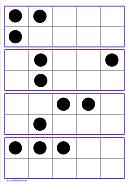Computation is the term used to describe any type of information processing (Bobis, Mulligan & Lowrie, 2008). It involves using a mathematical operation to solve a numerical problem (Origo, 2008). As teachers, we must put emphasis on the role of children's thinking in their mathematics learning, and build curriculum based on the development of children's concepts (Ell, 2002). Computation can be separated into 2 categories: computation using tools, and mental computation, the ability to calculate an exact numerical answer without the use of calculating tools (Origo, 2008).
A strategy like this will assist early childhood students in adding and subtracting numbers using mental computation. During these activities, the teacher could use some of the following questions to evaluate students understanding too:
- How did you solve that? Show us/tell us
- Did anyone else solve it that way?
- How is it the same?
- Who did it differently?
- How is that different?
- What do you think about those strategies?




No comments:
Post a Comment